Intro

Welcome! I am a CIERA Fellow at
Northwestern University's Center for Interdisciplinary Exploration and Research in Astrophysics (CIERA). My research explores galaxy evolution
and feedback processes across cosmic time, leveraging multi-scale, multi-redshift, and multi-wavelength observations. With extensive experience leading observational programs, securing competitive funding (including PI programs from
the
Hubble Space Telescope and
James Webb Space Telescope), and collaborating with theorists, I am excited to contribute to various aspects of galaxy evolution research.
Previously, I was a postdoctoral researcher at
Johns Hopkins University (2020–2023), advised by
Prof. Timothy Heckman and
Dr. Alaina Henry. During that time, I participated in several large collaborations, including the
COS Legacy Archive Spectroscopic SurveY and the Low-redshift Lyman Continuum Survey. CLASSY constructs the first high-quality, high-resolution far-ultra violet spectral database of nearby star-forming galaxies and I led the studies of galactic outflows in these galaxies. LzLCS builds the first large sample of galaxies with direct detections of Lyman continuum (LyC) at low-redshift, where I focused on studying the properties of Mg II lines and their correlations to LyC photon escape.
I earned my Ph.D. in astrophysics from
Virginia Tech, where I studied quasar outflows under the guidance of
Prof. Nahum Arav. Alongside my astrophysics research, I pursued an M.S. in computer science at VT, which has significantly enhanced my efficiency in data analysis for modern astrophysics.
To date, I have authored over 50 journal publications with more than 1,500 citations.
I’m always happy to connect and discuss science, research, or life in general. Feel free to reach out at xinfeng.xu@northwestern.edu.
Research Highlight
5. Correlations between outflow kinematics derived from absorption and emission lines within individual galaxies.
Our sample galaxies are shown in black, while models are represented in gray and purple.
In the left panel, we compare the maximum outflow velocity (\( v_{95} \)) measured from H\(\alpha\) and UV absorption lines.
In the right panel, we compare the blue-shifted line width measured from H\(\alpha\) and UV absorption lines.
Both panels reveal strong correlations with some scatter. The models suggest that both outflow diagnostics share a consistent outflow density distribution.
For more details, see Xu et al. 2025.
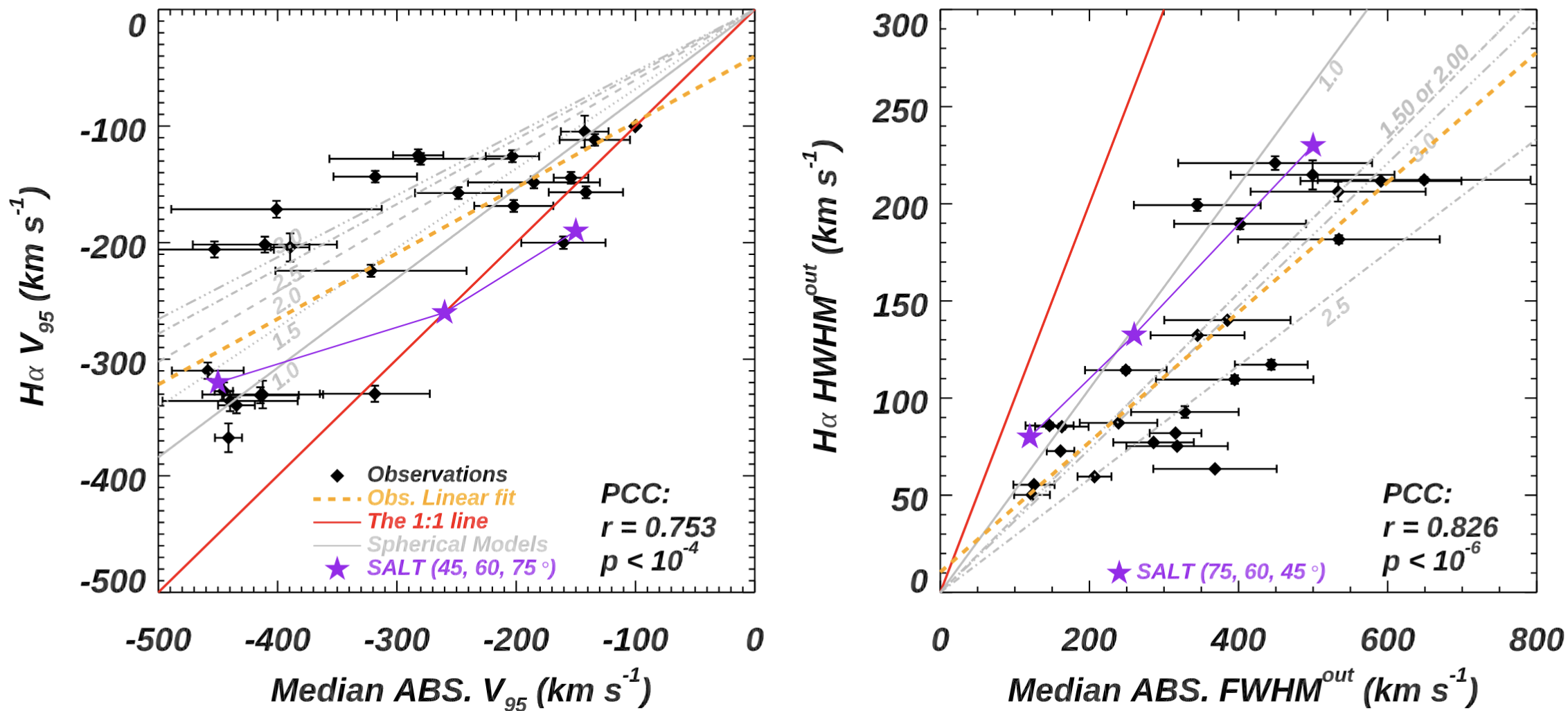
4. Radial distribution of outflow properties in the starburst galaxy M 82.
The panels (from top left to bottom right) show the radial distributions of the volume filling factor, mass outflow rate (\(\dot{M}\)), outflow velocity (\(V_{out}\)), energy outflow rate (\(\dot{E}\)), and momentum outflow rate (\(\dot{P}\)).
A key finding is that the outflow rates do not decline rapidly with increasing radius, indicating that the outflows in M 82 can transport significant mass, energy, and momentum to circumgalactic medium (CGM) scales.
For more details, see Xu et al. 2025.
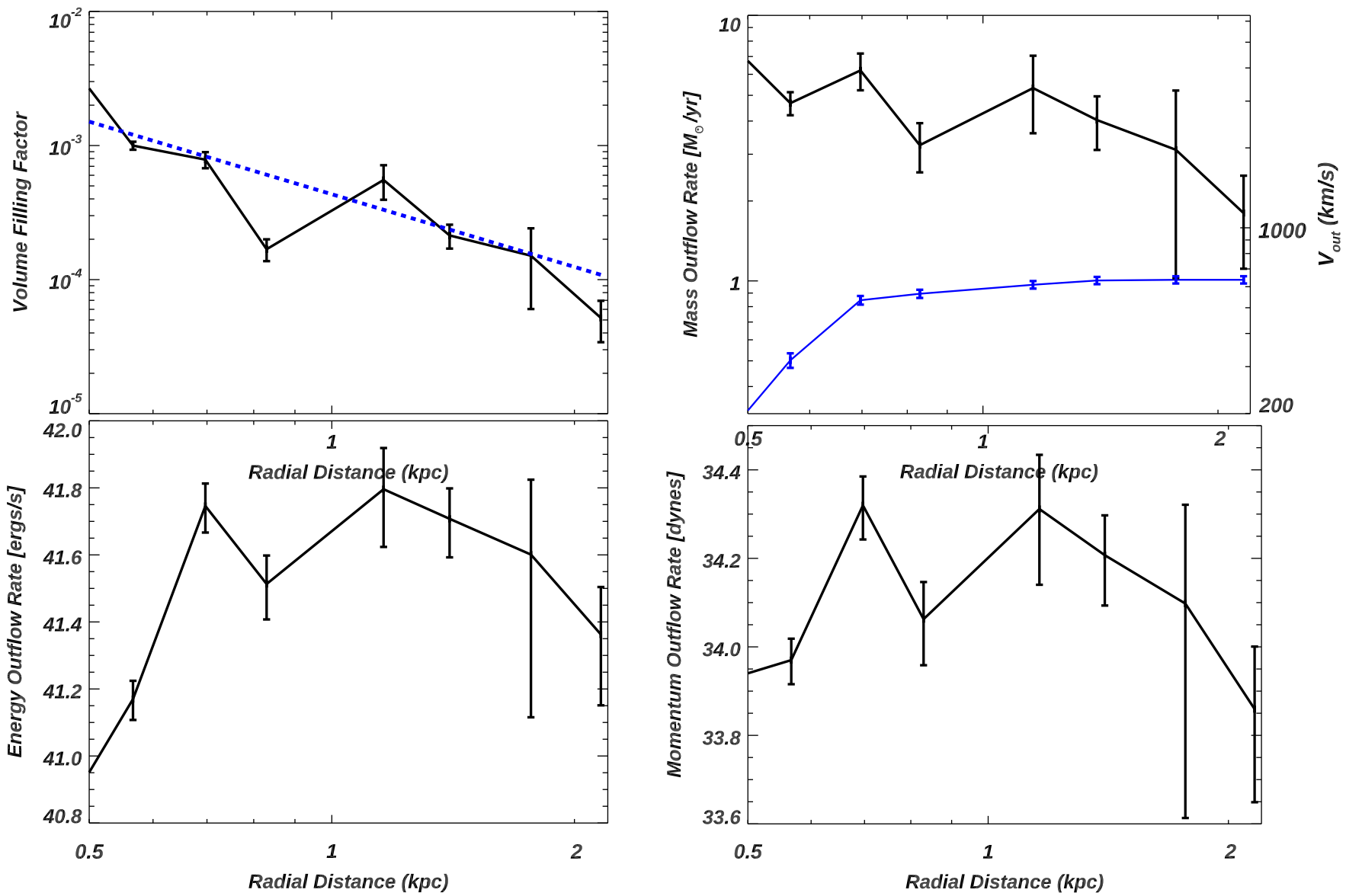
3. Strong correlation between SN-driven galactic outflow properties and host galaxy characteristics.
We present evidence that the properties of supernova-driven outflows are closely linked to their host galaxies.
The red points represent galaxies from the CLASSY sample, while the blue points correspond to those from Heckman et al. (2015).
The top row illustrates the relationship between outflow velocity (\( V_{out} \)) and galaxy properties, including stellar mass (or circular velocity) and star formation rate.
The bottom row shows similar comparisons but for the full width at half maximum (\( FWHM_{out} \)) of the galactic outflows.
For more details, see Xu et al. 2022a.
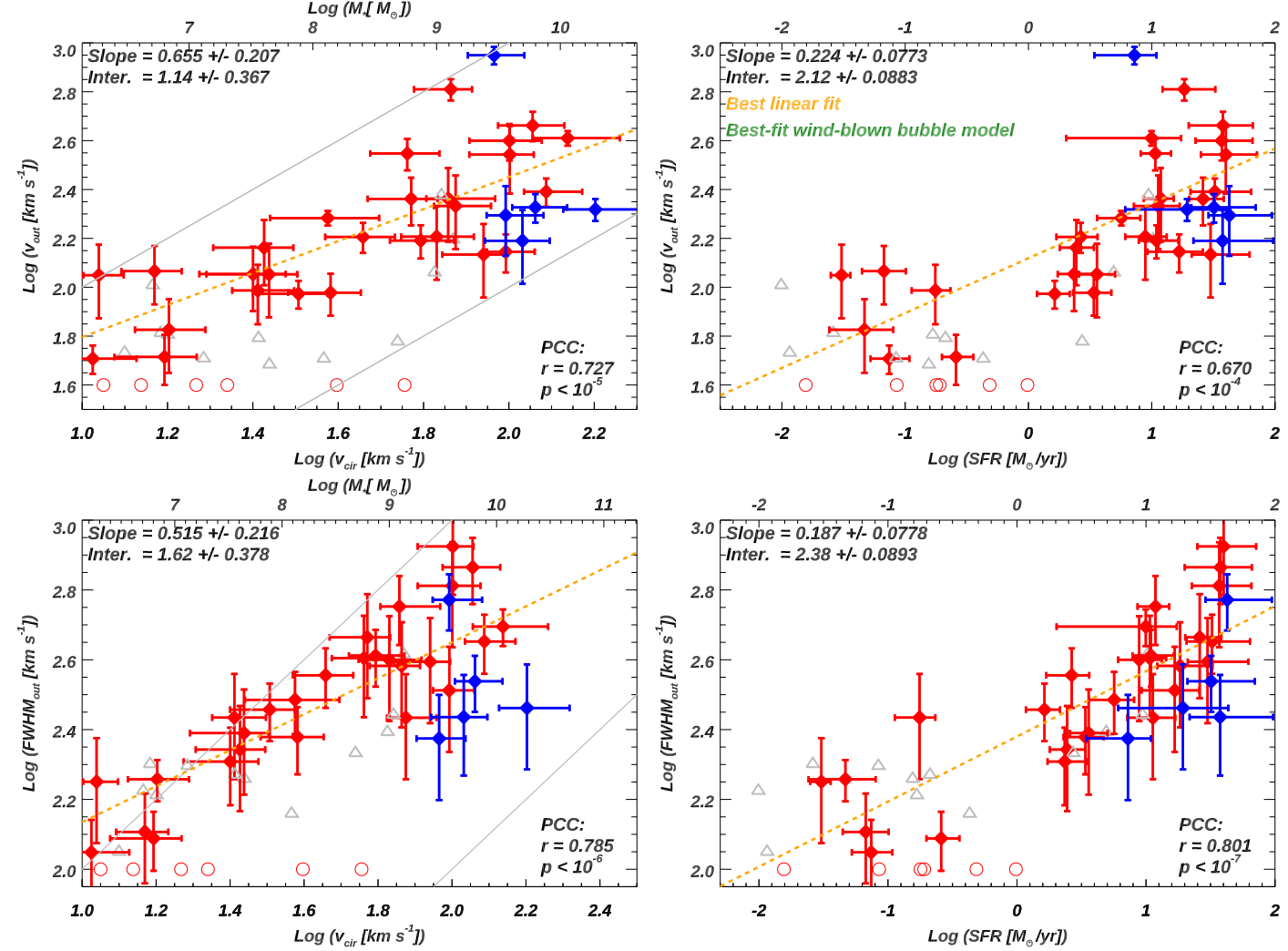
2. Correlations between Mg II and Lyα properties in galaxies from the Low-redshift Lyman Continuum Survey (LzLCS).
Galaxies with Mg II in emission are shown as solid symbols, while those with non-emission features (e.g., P-Cygni profiles or absorption) are represented as open symbols.
The left panel compares the net equivalent widths of Mg II and Ly\(\alpha\), while the right panel compares their escape fractions.
In both cases, we observe a strong correlation, consistent with the resonant scattering nature of Mg II and Ly\(\alpha\) lines.
These findings indicate that Mg II can serve as a valuable tracer of ionizing photon escape in galaxies that leak Ly\(\alpha\) and Lyman continuum (LyC) radiation.
For more details, see Xu et al. 2023b.
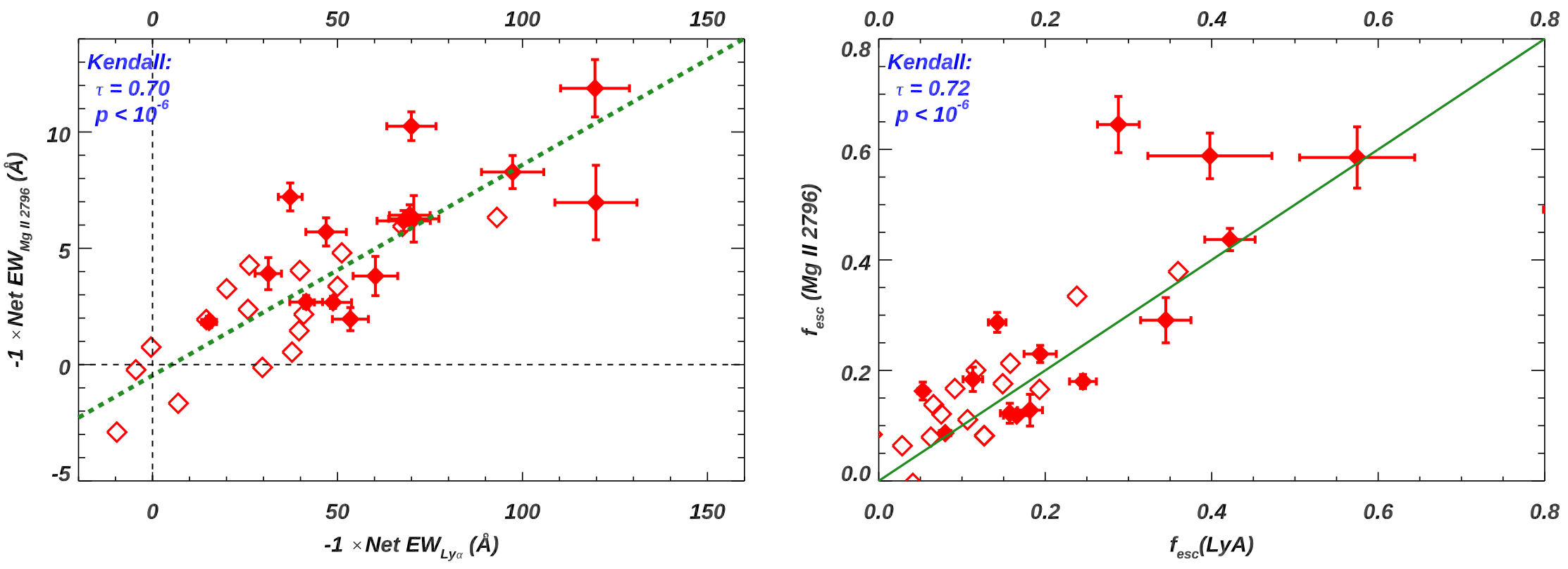
1. Acceleration of quasar outflows observed in SDSS J1042+1646.
The top and bottom panels show observations of quasar outflows from the 2011 and 2017 epochs, respectively.
We used the Hubble Space Telescope/Cosmic Origin Spectrograph to capture these data, which are displayed as black histograms with error bars in gray.
Gaussian fits for the strong ionic absorption troughs are shown in green and blue, while the sum of the model fits is represented in red.
Prominent Galactic ISM absorption lines are marked in orange.
Comparison of the two epochs reveals an average acceleration of 480 km s\(^{-1}\) yr\(^{-1}\) (1.52 cm s\(^{-2}\)) in the quasar's rest frame—
the largest broad absorption line (BAL) acceleration recorded at that time!
For more details, see Xu et al. 2020b.
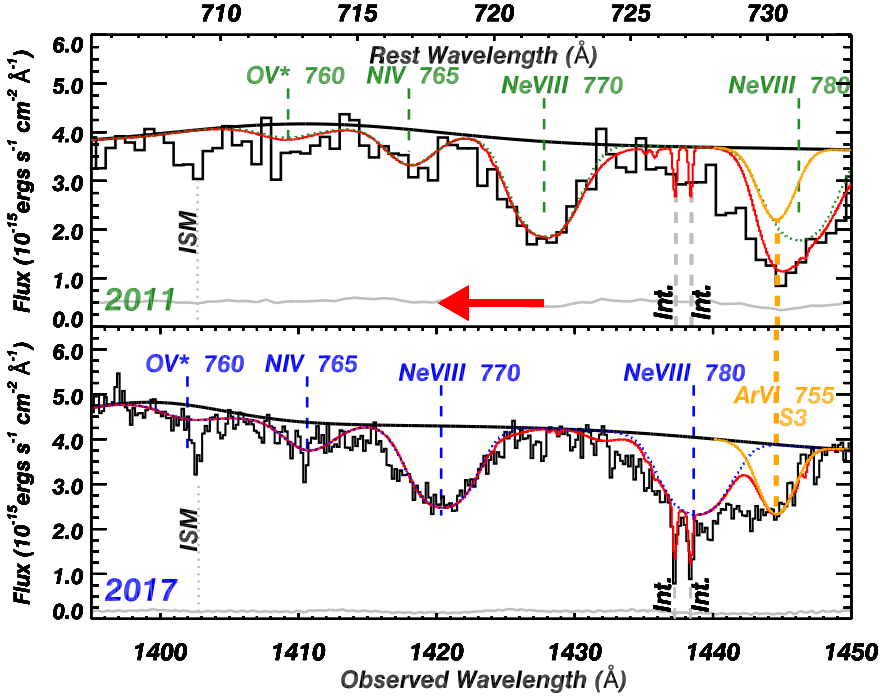
Research
You can find my list of publications in ADS or in google scholar!
CV
Elements
Text
This is bold and this is strong. This is italic and this is emphasized.
This is superscript text and this is subscript text.
This is underlined and this is code: for (;;) { ... }. Finally, this is a link.
Heading Level 2
Heading Level 3
Heading Level 4
Heading Level 5
Heading Level 6
Blockquote
Fringilla nisl. Donec accumsan interdum nisi, quis tincidunt felis sagittis eget tempus euismod. Vestibulum ante ipsum primis in faucibus vestibulum. Blandit adipiscing eu felis iaculis volutpat ac adipiscing accumsan faucibus. Vestibulum ante ipsum primis in faucibus lorem ipsum dolor sit amet nullam adipiscing eu felis.
Preformatted
i = 0;
while (!deck.isInOrder()) {
print 'Iteration ' + i;
deck.shuffle();
i++;
}
print 'It took ' + i + ' iterations to sort the deck.';
Lists
Unordered
- Dolor pulvinar etiam.
- Sagittis adipiscing.
- Felis enim feugiat.
Alternate
- Dolor pulvinar etiam.
- Sagittis adipiscing.
- Felis enim feugiat.
Ordered
- Dolor pulvinar etiam.
- Etiam vel felis viverra.
- Felis enim feugiat.
- Dolor pulvinar etiam.
- Etiam vel felis lorem.
- Felis enim et feugiat.
Icons
Actions
Table
Default
| Name |
Description |
Price |
| Item One |
Ante turpis integer aliquet porttitor. |
29.99 |
| Item Two |
Vis ac commodo adipiscing arcu aliquet. |
19.99 |
| Item Three |
Morbi faucibus arcu accumsan lorem. |
29.99 |
| Item Four |
Vitae integer tempus condimentum. |
19.99 |
| Item Five |
Ante turpis integer aliquet porttitor. |
29.99 |
|
100.00 |
Alternate
| Name |
Description |
Price |
| Item One |
Ante turpis integer aliquet porttitor. |
29.99 |
| Item Two |
Vis ac commodo adipiscing arcu aliquet. |
19.99 |
| Item Three |
Morbi faucibus arcu accumsan lorem. |
29.99 |
| Item Four |
Vitae integer tempus condimentum. |
19.99 |
| Item Five |
Ante turpis integer aliquet porttitor. |
29.99 |
|
100.00 |





